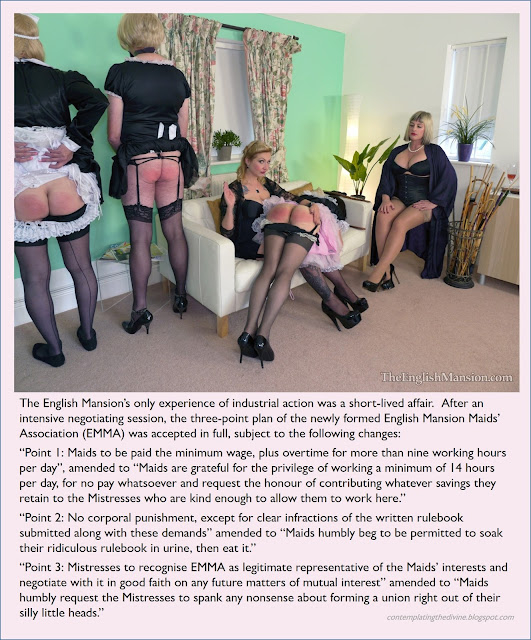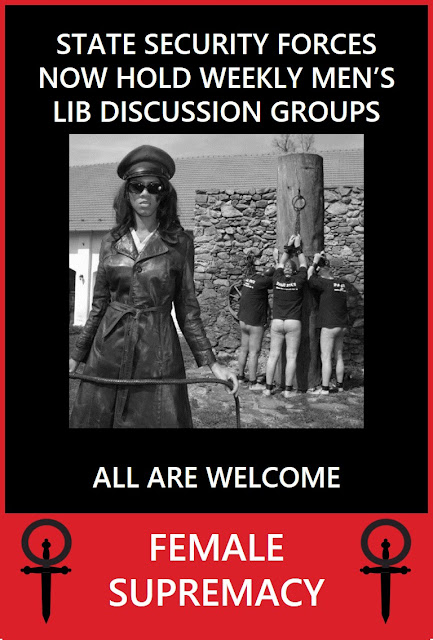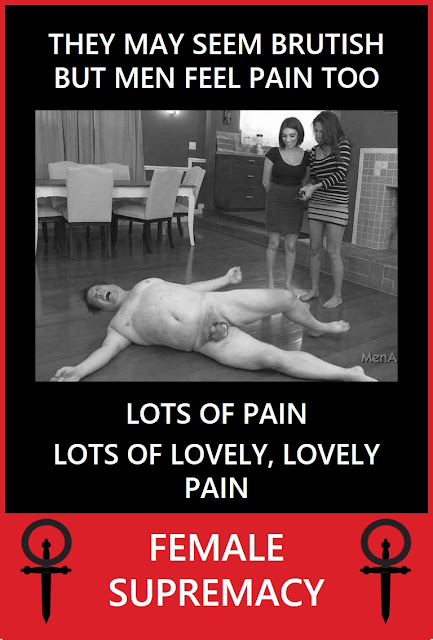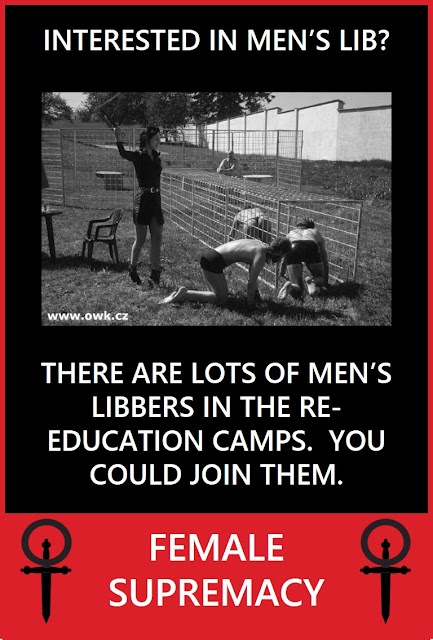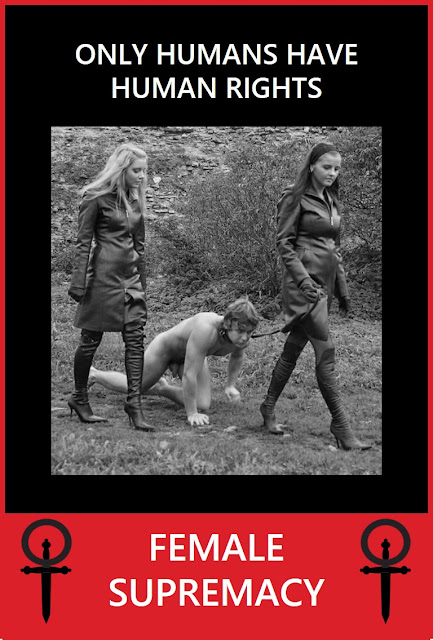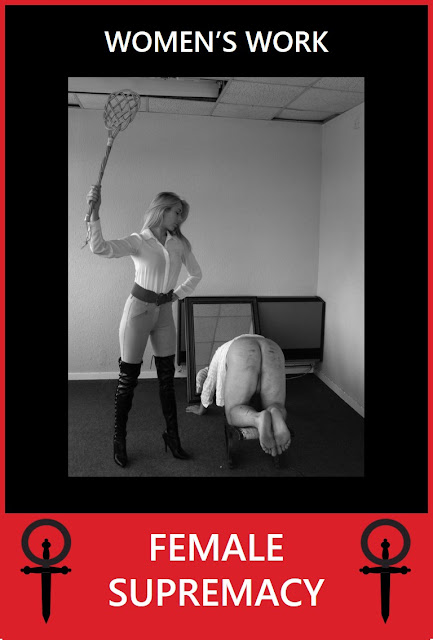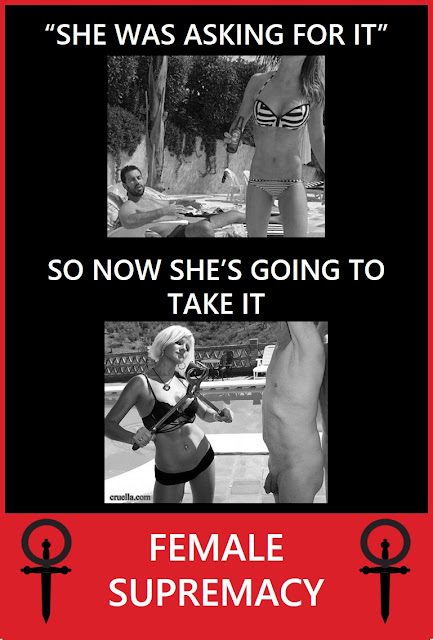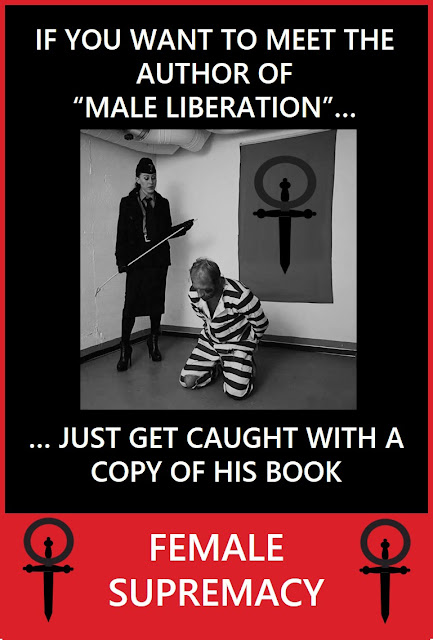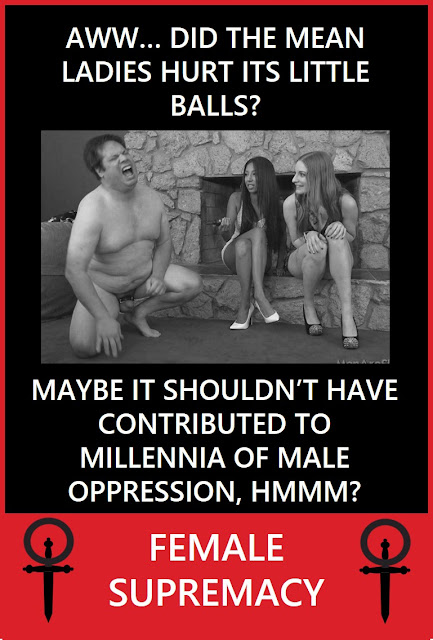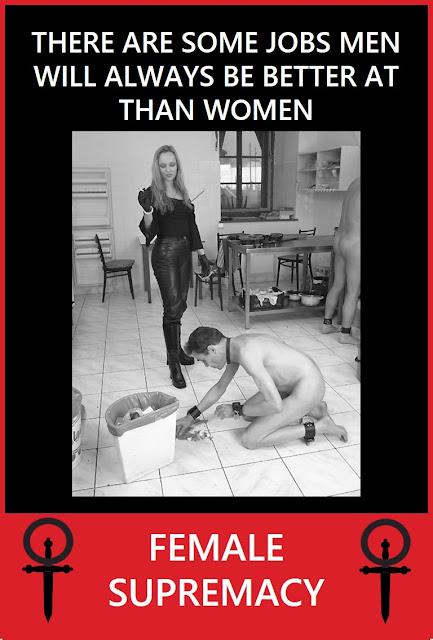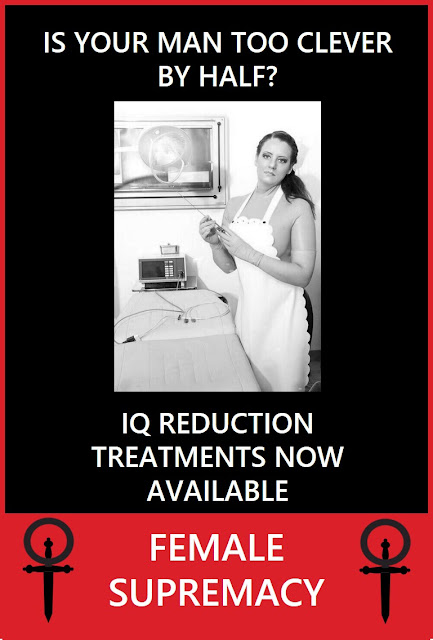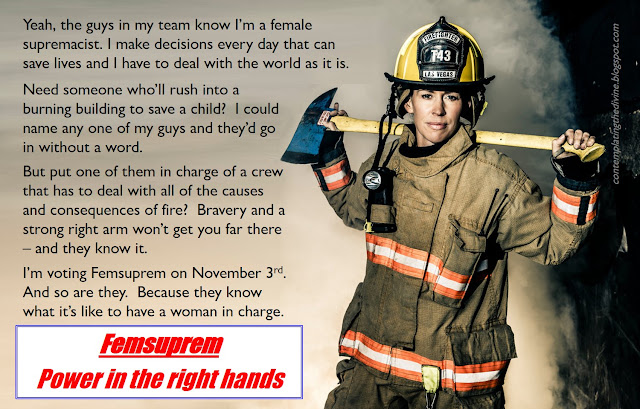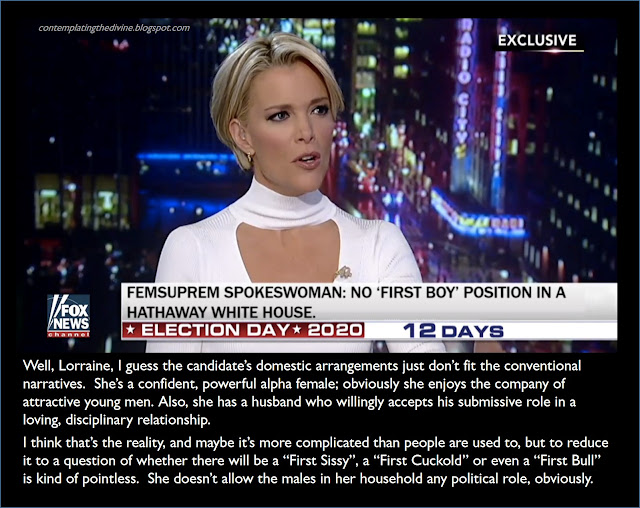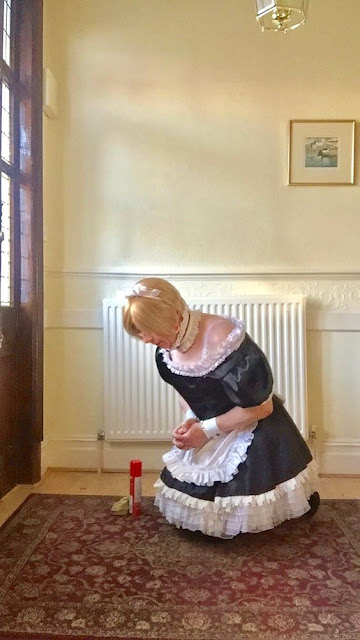In a change to the usual format, today we are publishing the preamble to an academic sociology thesis. Pretty hot, huh? You don’t get that on Men in Pain or Cum Eating Cuckolds, do you? Can’t imagine why not…
Extract from Male Liberation Theory: prevention and cure, a thesis submitted for the degree of Doctor of Philosophy in the Department of Sociology (Male Studies Unit)
Sheila Harrietsdaughter, King’s College, Cambridge, May 2086.
Alan Travis (as he was named at birth) is one of the more
interesting revisionist male liberation theorists. Reading his books in
sequence provides an insight into a fascinating philosophical journey. Born into a society almost unimaginable today, in which women had achieved mere ‘equality’ in society with men, he lived through the most profound and joyful social changes – changes that he, like many males, struggled at first to accept. His early works are hard to obtain, but even
the list of titles evokes the dilemmas he was forced to confront, as he redefined his views on male liberation and as his thought
developed and matured. A selective biography:
- Grateful thoughts from a
male feminist: how the women’s rights movement has given us all a more
equal society (2013).
- De-gendering social change:
the role of male allies in transformative feminist thought (2014).
- Let men help: the concept of
sexism and its interpretation by feminists and their male allies (2015)
- Women’s rights, political
correctness and male identity (2016)
- A united front against
sexism? The value of male voices in the feminist movement (2017)
- Not ‘all’ men are bastards:
deconstructing the divisive rhetoric of the ‘new’ women’s movement (2018)
- Reverse oppression? Sexism
and the ‘new’ women’s movement (2019)
- Criminalising men: sexist
jokes are not ‘rape’ (2020)
- The enemy within? Male
supporters of the ‘new’ women’s movement (2021)
- No votes, no voice – men’s
place in the ‘new society’ (2023)
- We will not be silenced:
free speech and the prohibition of ‘sexist views’ (2025 – unpublished)
- Second class citizens?
Men in the ‘New Society’ (2026 – unpublished)
- Voices in the darkness: the
testimony of male victims of the ‘New Society’ (2028? Published informally
by the men’s underground movement)
- Men’s Liberation – A
manifesto
(2030? Published informally by the men’s underground movement)
- “Writing this line over and
over again will help me to learn that my own opinions are of no
importance: women are in charge and we males will do as we are
told.” 20,000 lines written in Re-education Camp 9, published in six
volumes (2041,
writing as ‘Prisoner M847733847’)
- Eating dogshit – grateful
reflections on a re-educational stay (2043 – published by the Department of Male
Education and Correction, as part of their ‘The life that awaits you’
series for schools).
- Male Liberation – who needs
it?
(2044, writing as Alan Lucysboy)
- Why I do not miss my penis –
and nor does anyone else! (2048, writing as Alan Lucysboy)
- Much-needed correction: a
humble appreciation of the first 25 years of the New Society by a
well-disciplined male (2051, writing anonymously as ‘Boy – aged
61’)
- Pleats and seams – the
complete guide
(2056, writing as Alan Elainesboy, Volume 13 in Ironing for Men).
- What silly boys we were: a
personal recollection of the Male Liberation movement and its ridiculous
ideas (2061,
writing as Alan Elainesboy).
- Good for nothing – a last
testament from a soon-to-be euthanised surplus male (2068, published posthumously
as Alan Nobodysboy).
By chance, the last item on this prolific list of
publications was discovered by a worker at the male disposal plant who had read
and greatly enjoyed some of Alan’s later works.
Accordingly, rather than being boiled down for glue, his body was taken
to King’s College in Cambridge, where he had held a fellowship until 2025. He was stuffed and mounted in a corner of the
dining hall, where he remains today, in mute testimony to the remarkable
achievement of the New Society in convincing even its most strident critics of
the justice of female supremacy.
This thesis is concerned with why Alan altered his views so
profoundly in mid-life. Of course, a
facile answer is “Because he spent over ten years in a re-educational camp
being starved, whipped, electrocuted and forced to eat excrement”.
Indeed, a cursory reading of some of his later works, notably Eating Dogshit (2043), would seem to confirm
this. However, I believe that a closer
examination of his works points to a more fundamental realisation and acceptance of his own
inferiority, and by returning to the original manuscripts of his texts –
including the profoundly moving 20,000 Lines, stained in places with the
philosopher’s own tears – I intend to show that…
….
(and so on and so on for another 98,000 words. I’ll post the rest some time when I have nothing better to do and the Internet really needs another PhD thesis).
Let’s just finish with the photo appendix. What do you mean, real PhD theses don’t have photo appendices? My own thesis, submitted last year, had over 3000 images. It still rankles that they rejected it. Call themselves a Women’s Studies department and what do they do when someone submits a thesis that entirely consists of studying women, close up and personal? They call it ‘porn’. Oh well. “Dr Servitor” sounds a bit weird anyway. Back to Dr Harrietsdaughter’s work:

Plate 10: This photograph, used to illustrate one of Alan’s early works, has
puzzled researchers for years. Captioned merely “The worm that turned”
it appears at first sight to show an ordinary unit of Re-education Corps
Servicewomen going about their work. However, the Corps was not established until 2030: 11 years
after the book in which it appeared. Furthermore, the Corpswomen are wearing extremely small shorts, indicating a hot summer day, yet the weather appears to be anything but hot. Research into the undeleted
fragments of the Male Internet (access permitted under scholastic
exception), associates it only with the phrase “The two Ronnies”, who were presumably early female supremacist thinkers both called Ronald, whose work has now been lost.

Plate 13. This illustration, from No votes, No voice (2023, restricted access), reproduces a poster widely used by the male resistance. Titled “The Future Under The New Society”, the poster was presumably intended to alarm males and to encourage them to cast their votes (odd as it is today, to contemplate males voting) for masculinist parties. However, in a classic example of male incompetence, the poster backfired and is credited with boosting the New Society vote by ten percentage points or more among males, who seem to have found the image attractive. Such self-defeating displays of stupidity were a recurring feature in the male resistance movement, as Alan himself thankfully recorded in What Silly Boys We Were (2061).
Plate 19: Malcolm Harris. Harris collaborated with Alan on some of his early works, in particular the so-called Men’s Liberation Manifesto (not available for public distribution),
several versions of which circulated secretly among subversive males
around 2030. Harris believed that only violent action could overthrow
the New Society, leading a party of armed subversives hiding out in the
Yorkshire Dales for over two years, before being betrayed by a
submissive male posing under-cover. Harris made occasional covert radio
broadcasts, including the famous “Call to Arms” of 2031, which Alan
described as ‘inspiring’ at the time, but later admitted to have been “a
petulant stamp of the foot: a tantrum by a spoilt brat who was
severely overdue for a spanking.”. The photograph shows the former
Harris (renamed ‘Scrub’) some years later.

Plate
24: This photograph shows ‘Prisoner M847733847 during his years in a
re-educational camp. Note the penis: in these early years of the New
Society, male re-educational inmates typically retained their penises
and testicles, although in most cases these items became too damaged to
function as a result of the repeated application of increasingly
sophisticated re-educational techniques
The re-educational officer to the right of the Prisoner, Karen Susansdaughter, was by chance a former student of his when he had lectured at Cambridge. Interviewed in the course of research for this thesis, she cheerfully recalled how pleased she had been to discover him in her cell block, and the many opportunities it provided to reprise their warm disagreements over female supremacist philosophy. The officer to the left has not been identified but may be the “Anna” whose name was branded onto Alan’s thigh at some point during his stay.

Plate 27: an illustration from Eating Dogshit (2043). Note the lemon slice on the side of the bowl, which has caused much confusion to historians of the period. In contrast to some erroneous claims made regarding this image (e.g. Too soft on the bastards? Re-education camps in the early years of the New Society in The United Queendom, Francine Fille-de-Marie (2062)), this does not represent an actual food bowl from Prisoner M847733847’s re-educational camp. Rather, in the second chapter of Eating Dogshit (op .cit.), the author eloquently describes the essential pleasures of drinking a bowl of clean slightly lemony water, presumably after his release, to establish a contrast for the chapters that follow, which describe the experience of being forced to eat dogshit in the detail that is now familiar to generations of male teenagers from compulsory study classes (but are best avoided by female citizens without very strong stomachs).
These chapters can be envisioned simply through their evocative titles: “The Smell”, “First Refusal and its Consequences”, “Begging Permission to Eat”, “First Taste”, “Second Refusal and its Consequences”, “The First Mouthful“, “The First Swallow”, “Pleading for Water”, “The Whip”, “The Second Mouthful”, “Chewing”, “Swallowing”, “Vomiting”, “The Whip, once more”, “Re-ingesting”, “Licking the Bowl, “Gratitude”, “Once is not Enough”, “No Easier the Third Time”, “A Weekly Dogshit Day”, “Attempted Suicide”, “My Life is not My Own to Take”, “Grateful Acceptance and Weekly Treats”, “An Aftertaste for Life”.

Plate 28: Alan and his first Responsible Female, Lucy Deborahsdaughter, enjoy a riding holiday in France. Riding became an increasingly important part of Alan’s life in his Lucysboy period and the couple were a familiar sight around the hills and lanes of West Derbyshire, where they lived. Alan’s waning strength as he aged led Lucy first to castrate him, in the (mistaken) belief that geldings are stronger and then to sell him on e-bay.
Although academic institutions bid for him, keen to possess such a well-known figure on the philosophical landscape, Lucy decided in the event on a private sale because, as she put it “the little bastard needs to work for his keep, not laze around on display in a museum”. His eventual buyer cheerfully admitted that she had never heard of him or read anything he had written – nor indeed ever did she. But it was to be in Elaine Ruthsdaughter’s laundry room that Alan was finally to discover a philosophy of contentment – and personal happiness at last.

Plate 32: This image, from the frontispiece to Pleats and Seams (2056) shows Alan soon after Elaine Ruthsdaughter became his Responsible Female. Often treated merely as a practical guide to ironing, of no use to anyone except household sissies, this work can also be read (albeit at the price of extreme tedium for the average citizen, who will never have to iron a pleat in her life) as a subtle and mature work reflecting on how males can find purpose in menial acts that provide some service to the superior sex. As Helga Fridastochter has written in Spanked, Serving and Satisfied (2072): “There can be few intellectual journeys more inspiring than that of Alan Travis, from the petulant claim in 2019 that men’s self-realisation demanded full participation in the government of society, to Elaine’s happy houseboy, ecstatically recalling her murmur of ‘good boy’ following four hours of work on one of her long pleated skirts that he loved so much.”
